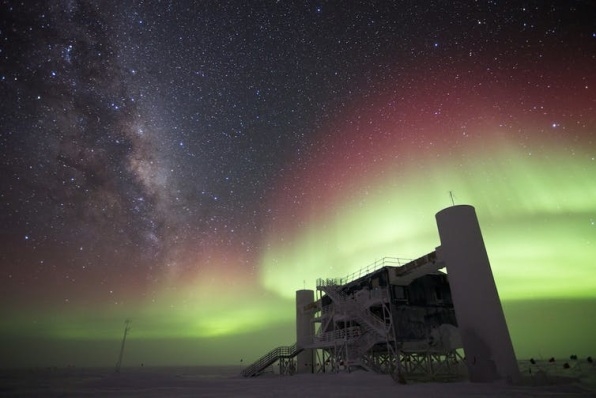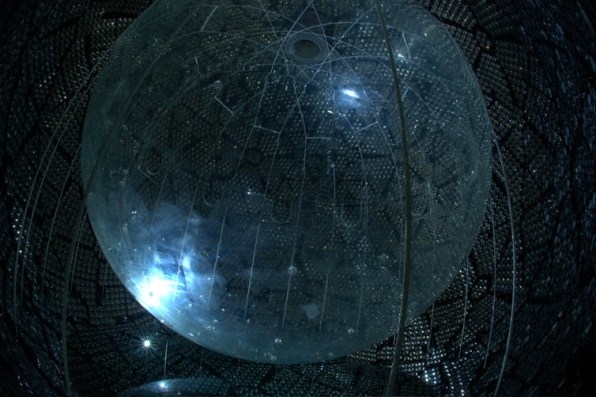What do a big chunk of ice at the South Pole, a mine in northern Ontario, and a mountain in Italy have in common? They’re all home to extreme underground environments, but they’re connected in another, more unexpected way. All three are host to large physics experiments searching to understand and answer the most basic questions about the world around us.
As a research scientist at SNOLAB in Sudbury, Ont., I get the chance to talk to a lot of different people about the work we do. The question often comes up: Why are we doing astrophysics–the study of space and the cosmos–from deep underground?
In particle physics, we long ago answered all of the questions that could be answered through tabletop experiments run by small groups of scientists in small laboratory spaces. Albert Michelson and Edward Morley showed that “luminiferous aether” didn’t exist, using a light source and mirrors on a bench-top stand. Marie Sklodowska Curie discovered polonium and radium in a shed next to the school of chemistry and physics at the École Normale Supérieure in Paris.
Fortunately, or unfortunately, we’re now asking bigger questions–we are looking for the nature of the universe: What gives particles their mass? What kind of particle is the neutrino? What is the rest of space made of? What is dark matter? Bigger questions require bigger experiments, which need bigger groups of people making them function.
The way to answer these questions is not just to build bigger detectors, but also to think carefully about where we put these detectors. So, scientists build detectors deep underground. We use kilometers of the earth as a dense shield to stop the particles we don’t want to detect.
The neutrinos and dark matter that we are looking for are unlikely to be stopped by the rock, so they are free to keep traveling to our detectors. The deeper we go, the more of this shielding we have.
Antarctica
Take for example IceCube, the experiment built directly into the South Pole. Looking for the highest energy neutrinos requires a cubic kilometer of ice to be buried under another 1.5 kilometers of ice.

[Photo: IceCube/NSF/Ian Rees]
If you’re standing on the South Pole, the bottom of the detector is 30 city blocks below you! There are over 5,000 light sensors distributed through this volume, with cables stretching to a surface control building from which the experiment is run.
This project requires over 300 people across 12 countries. Professors, students and technicians are all working on building electronics prototypes, testing techniques to drill into the oldest ice on the planet, and writing computer code to analyze all that data. There is no one country, much less one single university, that could supply all the necessary resources.
Canada
SNOLAB, Canada’s deep underground astroparticle physics laboratory, is in an active, working nickel mine over two kilometers underground. There is a rich history of particle physics experiments operating in mines, beginning in the 1960s.
Compared to experiments hosted in shuttered mines, working in an active one makes some aspects easier, because scientists don’t need to worry about operating the mine elevator (called the cage) or pumping groundwater out of the mine. But the size of the cage, and the mine tunnels (called drifts) limit the size of items that can be transported into the lab. Overall, the detectors’ increased sensitivity from all of the shielding is worth the effort.

Italy
LNGS, the National Laboratory of Grand Sasso, is a 17.8 sq. kilometers lab in the heart of Italy built underneath a mountain, within a national park, adjacent to a freeway tunnel. This provides an underground space without the logistical challenges sometimes posed by working in a mine.
The hours of access aren’t governed by someone else’s mining schedule, and being able to drive your detector straight into the lab is a definite bonus. But its space is limited, and the 1.4 kilometers of mountain rock above provides less shielding, which ultimately limits the capabilities of the 16 experiments it hosts.
Being in these unusual locations can be difficult enough, but working in large groups provides interesting challenges and international collaborations are the norm for most experiments.
Global Collaboration Challenges
SNOLAB is home to eight particle physics experiments (DAMIC, DEAP-3600, HALO, MiniCLEAN, NEWS, PICO, SNO+, SuperCDMS) that are managed and run by scientists from 79 institutions in 14 countries around the world. Beyond the physical logistics of doing science, we have the human logistics of working in large groups and across borders.
We have to keep each other updated on the day-to-day workings of making science happen. This means conference calls, and their coordination.
As collaborations span the globe, Doodle meeting scheduler polls span time zones, searching for the hours that will inconvenience the fewest people. Audio and video conferencing tools that physicists use to communicate with each other abound, including EVO, Uberconference, Vidyo, and Zoom. My calendar is peppered with at least two to four calls a day–every… single… week! This can be tedious, difficult, and time-consuming but phone meetings are much better suited for making decisions than infinite email chains.
Beneath The Earth And Across The Globe
Another big challenge is in-person meetings. The majority of collaboration projects get together a few times a year to catch everyone up on what’s been going on. This means that at any given time, most people involved in a project must travel.
A large portion of a group leader’s grant will be spent on travel funds for herself or himself and their postdoctoral researchers and students. Depending on what stage the experiment is in, the meetings might be held at the experiment’s site, or hosted by different collaborating institutions.
These trips can be great opportunities to actually see the project for which you might only be analyzing the data. They also offer a chance to explore another country’s culture while making professional connections with colleagues.
Regardless of what you are doing in particle physics, filling up your passport is a given in this field. And depending which experiment you work on, you might not just travel across the globe, but into it as well.
Erica Caden is a research scientist at SNOLAB. This article first appeared at The Conversation.
Fast Company , Read Full Story
(28)